ELEKTRON AG optimizes the sales process with simulation automation from CADFEM
COOL: THE PERFECT SOLUTION - IN HALF THE TIME!
An ELEKTRON heat sink is perfectly tailored to its application. The elements that are indispensable for industrial power electronics are “vital” and sometimes take on considerable sizes. The design is as unique as the areas of application. With a simulation app programmed by CADFEM, ELEKTRON AG is able to provide its customers with an optimal solution in half the time it used to take, without the need for extensive simulation knowledge.
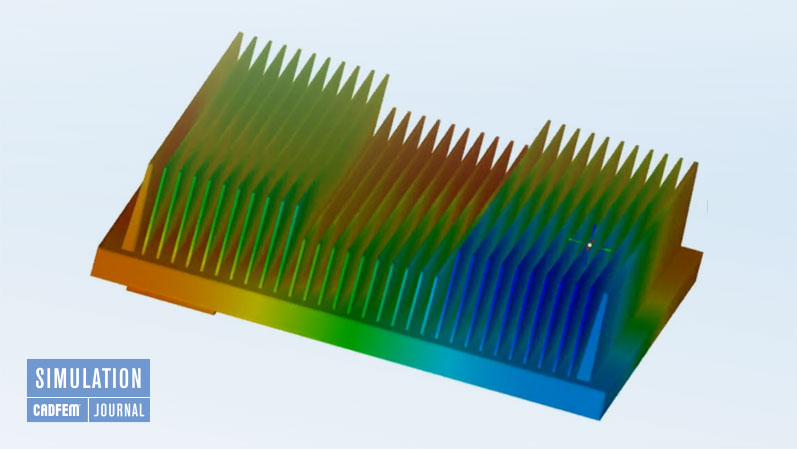
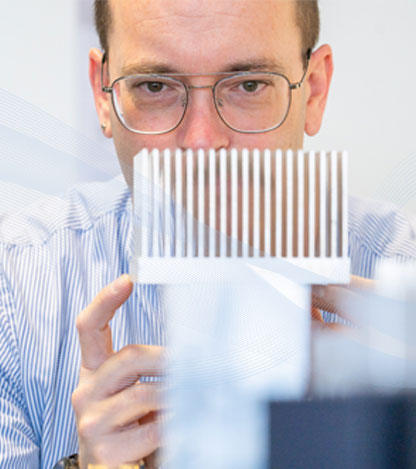
When you open your laptop on the train and connect the power supply to the on-board socket, there is a good possibility that this only works because perfectly optimized heat sinks from ELEKTRON AG protect the train’s converters from overheating. ELEKTRON AG, based in Au on Lake Zurich, is a leading Swiss technology company in the industrial and energy markets. Founded in 1951, the company has just over 80 employees at three locations and offers solutions in the business areas of drives, power electronics, engineering, payment systems, and smart city and lighting. Common to all solutions is the goal of minimizing resources and increasing energy efficiency. In the field of electronics, heat sinks are a key component. They are used to dissipate heat and protect against thermal-related failures.
Technologie Company ELEKTRON AG
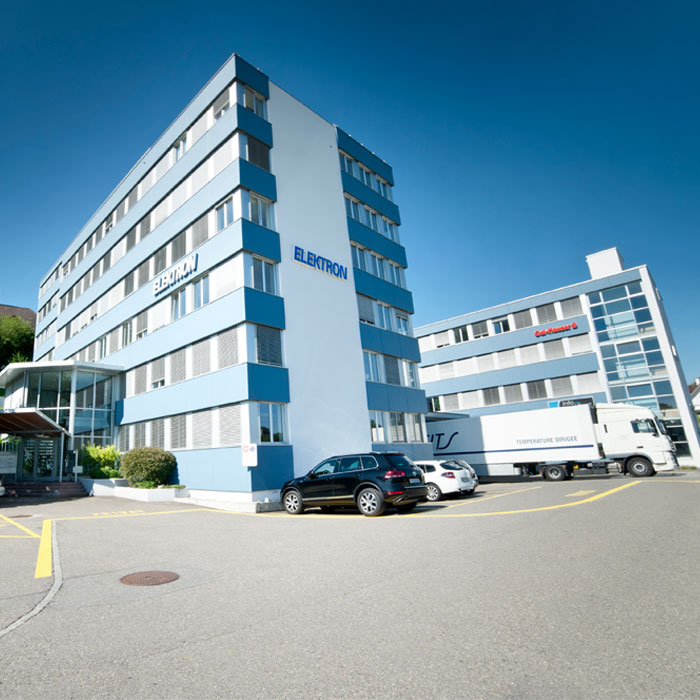
ELEKTRON AG is a leading Swiss technology company with just over 80 employees actively engaged in the energy and infrastructure market for resource minimization by increasing energy efficiency. ELEKTRON sees itself as a link between international technology companies and the individual needs of customers. In this way, the company is able to offer intelligent solutions for efficient systems in five different business areas: drives, power electronics, engineering, payment systems, smart city and lighting.
Individually optimized heat sinks for power electronics
ELEKTRON AG offers both standard and freely configurable profiles for power electronics according to customer requirements. Individually optimized heat sinks range from the dimensions of an A4 sheet of paper to the size of a Euro pallet. They are variable in terms of the distances and lengths of the cooling fins as well as the base thickness. During manufacturing, ELEKTRON relies on a range of proven technologies, each offering specific advantages depending on the application.
As product manager for mechanics at ELEKTRON AG, Sascha Walker is the first point of contact when it comes to freely configurable designs for heat sinks. He sums up the challenge: “for us, the specific requirements of the customer are paramount. We do this justice by developing a tailor-made heat sink solution for our customers. It originates with us in pre-development, where we consider the different manufacturing technologies in conjunction with various geometries. We then simulate the cooling performance of the model. In this way, the best individual heat sink solution is created, taking into account cooling capacity, pressure loss, material, weight and costs.”
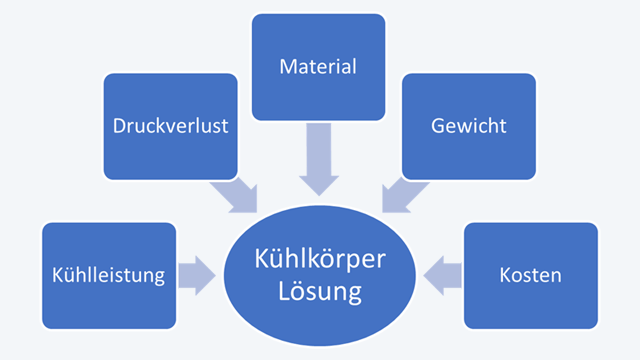
Simulation wonder
Only after the optimal virtual model has been evaluated does this result go into prototype construction. The physical prototype is an individual part and comes at the end of the development process. It is the last instance before release to the customer. Due to the large dimensions and high costs involved in prototyping, it is only used for real verification of the optimal virtual variant that has already been found using simulation.
Without simulation, the physical prototype would be the starting point for discussions and adaptation cycles, which has an adverse impact on price and time. ELEKTRON AG has been able to halve the time to market by using automated simulation tools. Such a massive increase in efficiency must seem like a wonder to those who are not familiar with the application possibilities of modern simulation tools. However, behind this supposed “wonder” is simply a wealth of know-how and powerful software, both of which are ELEKTRON AG has successfully implemented into the company.
Automated simulation with CADFEM
This very efficient process cycle is based on the use of automated simulation. To achieve this, ELEKTRON turned to CADFEM with a set of specifications. CADFEM systematically opens up the world of numerical simulation to its customers through the know-how it has built up since 1985. As an Ansys Elite Channel Partner, CADFEM offers solutions with one of the world’s best simulation software providers. In particular, small and medium-sized enterprises (SMEs) and operating organizations divided into profit centers benefit from CADFEM’s extensive knowledge of simulation automation. You don’t necessarily have to set up your own resources in order to use simulation more efficiently.
Requirements in the specifications
Sascha Walker describes the requirements that were placed on CADFEM (Suisse) AG in the specifications: “we wanted an easy-to-use app with parameterization and Excel as the user interface, in which geometry creation and the meshing of the body - required for the simulation calculation - take place automatically after entering the boundary conditions. The results are output in an HTML report with 3D view. All input data is processed based on Ansys Fluent as a reliable simulation software for computational fluid dynamics (CFD). The goal of simulation automation was, above all, to reduce the time required to go from design to simulation to results.”
Touchstone customer project
CADFEM (Suisse) AG implemented the requirements from the specifications as requested. The efficiency of the solution was soon demonstrated in one of the first projects at ELEKTRON AG. The customer wanted to reduce the thermal resistance (Rth) of an existing heat sink by ten percent. To achieve this, the previous aluminum heat sink was first analyzed using the CADFEM heat sink app. The analysis showed an Rth value of 16.4 for this heat sink. The question now was whether a modified design (that uses either extrusion or laser welding as the manufacturing technology) would lead to the necessary savings.
App in Action
The CADFEM heat sink app provided a suitable answer as quickly as it did reliably. The input is very simple and can be done by anyone working in design. When the app is started, a clear Excel form is opened. Fields that require input are highlighted in blue. The basic dimensions of the heat sink are entered in the form of length and width as well as the height of the base plate. The intended material type is also stored in Excel. Defining the number, width and height of the fin packages is just as easy. The material can be selected for each fin package. With extrusion as the production type, production-specific material specifications are identical for all packages and the base plate. With laser welding, the flexibility is greater, since various fin materials can be applied to the base plate.
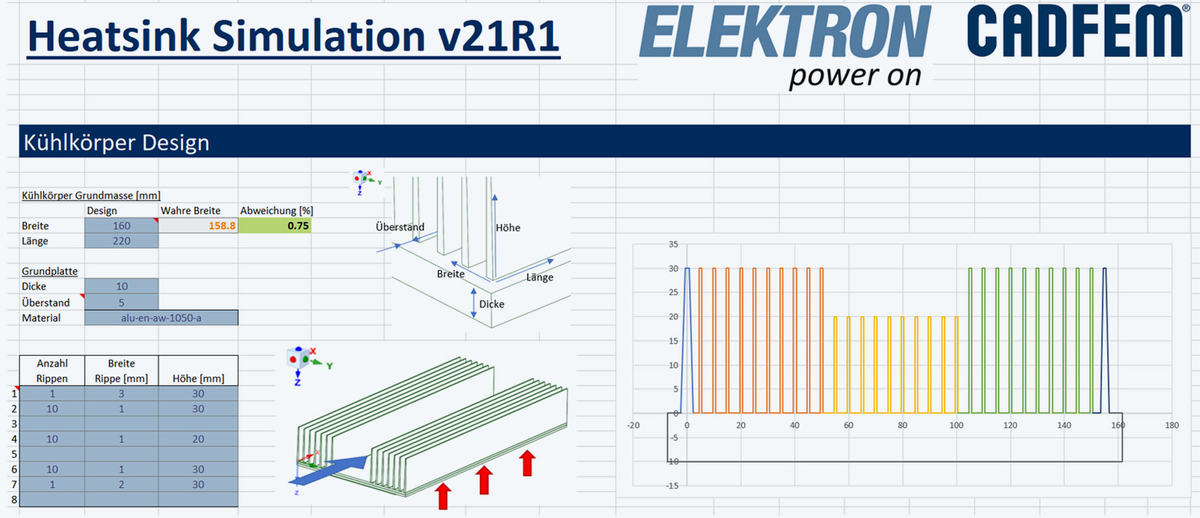
In the next step, values for the load case (areas of the heat sources) and the cooling parameters (inlet temperature and velocity) are entered. In addition, the extrusion height and power of the semiconductor device (IGBT) can be determined. In the last step, a preview (2D section) of the geometry is shown in the evaluation, in which there is once again the possibility to make adjustments.
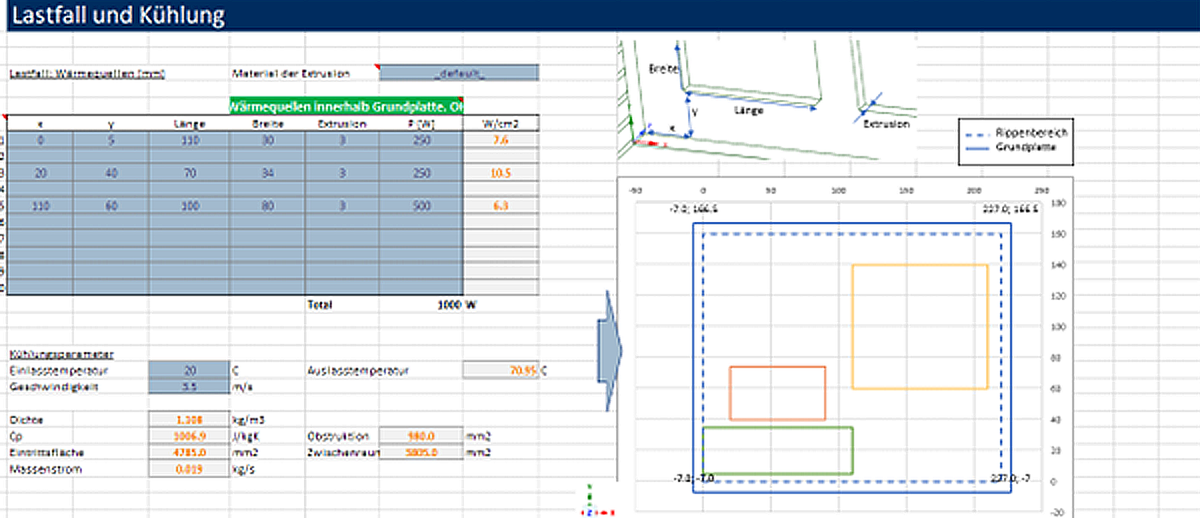
With the push of a button, the calculation can be started in Ansys Workbench from the Excel form. This simulation work environment contains several software packages and supports the “Ansys Customization Toolkit”, ACT for short, with which simulation processes can be automated in the form of so-called “wizards”. The ACT script, programmed by CADFEM for ELEKTRON, independently takes over the values from the Excel form and sets up the geometry in Ansys SpaceClaim, a fully-fledged 3D CAD program, representing a solid basis for calculations and models.
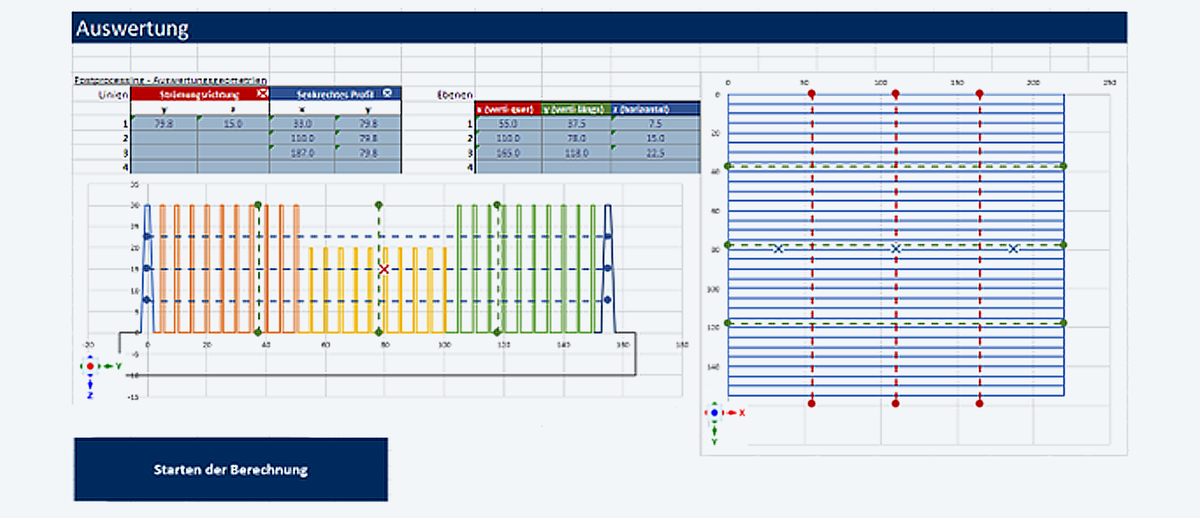
As soon as the geometry is in place, the Ansys Workbench “meshing tool” automatically takes over the meshing of the model. The more tightly meshed the geometry is, the higher the number of nodes that provide feedback to the simulation about the respective physical conditions at that point. Since ELEKTRON heat sinks can take on large dimensions with hundreds of cooling fins, CADFEM has included structured meshing with “edge sizing” in the flow. This reduces the calculation to the relevant points and speeds up the computational process without losing significance.
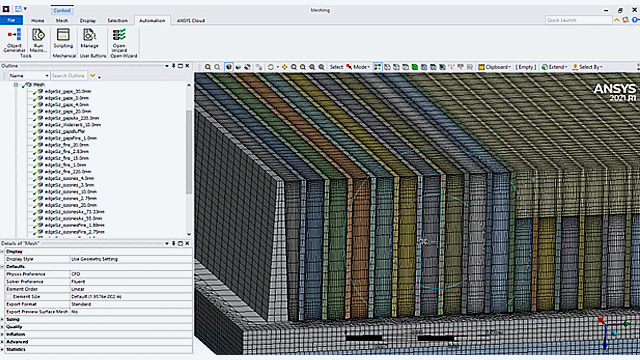
Once the intelligently structured meshing has been set up, Ansys Fluent is automatically started in order to carry out the flow simulation (CFD). Here, all the information from the Excel values and the SpaceClaim 3D models come together in the form of a dynamically generated “journal” and go through all iterations of the CFD simulation.
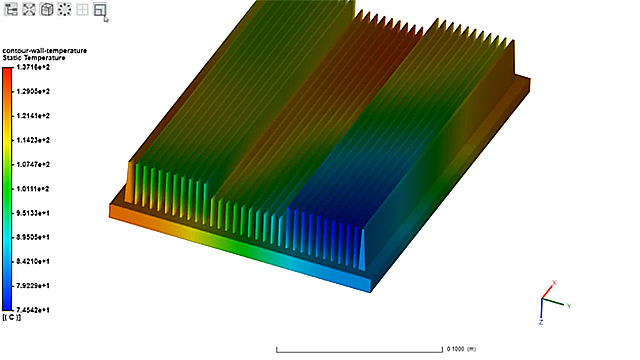
As a result report, a detailed “Heat sink simulation report” opens in HTML in the browser. It contains all information, tables and diagrams about the parameters used in the simulation as well as the results. The 3D model can also be found there at the end. The critical zones are immediately visible in the color gradient, and a zoom and rotate function enables precise viewing. All this without leaving the browser environment.
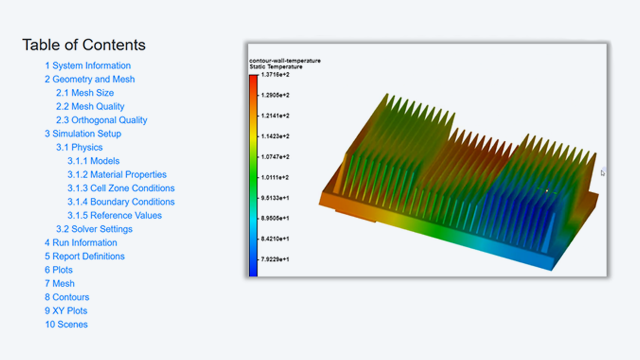
Customer request solved in record time
To solve the customer requirement described at the beginning, Sascha Walker made three calculations using the CADFEM app: one for the previous heat sink design, with an Rth value of 16.4, then an extruded version, which proved useless with an Rth value of 19.7, and finally a laser-welded version, which yielded an Rth value of 14. From the 10% improvement in Rth value requested by the customer, ELEKTRON was able to present an optimized heat sink design with a 14% improvement. The customer’s expectation was clearly exceeded. Added to this success was the speed with which the optimization was carried out. Sascha Walker sums it up positively: “in close cooperation with CADFEM (Suisse) AG, we were able to automate the simulation process for forced heat sinks and halve the development time on average. In the specific example here, this was significantly exceeded. With the standard approach, we needed 12 hours. However, with the automation of the CADFEM heat sink app, we reached the goal in 5 hours.” A “cool” result that prompted ELEKTRON AG to increase design testing in combination with simulation as a valuable service for its customers.

ELEKTRON AG
Sascha Walker
www.elektron.ch
Author: Thomas Löffler (freelance editor)
Images: © ELEKTRON AG
Published: December, 2022
Contact CADFEM (Suisse) AG







